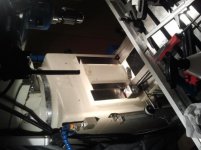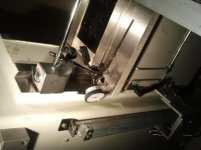xavier2089
Plastic
- Joined
- Nov 29, 2016
Hi all, first thread but a long time reader (from Adelaide, Australia). Hopefully this post is in the right section.
I have searched this forum but could not come up with the exact information/ answers so if I have missed it, please advise me.
To start with the problem: I have a brand new Taiwanese turret milling machine (similar to a Bridgeport) which was jumping in the z-axis (knee).
After trying to adjust the knee gib (taper type with locking and adjusting screw) the best I could, I was getting about .002 inch movement (with a dial indicator set up on the y way of the knee to the z way on the main body of the mill) moving the knee up and down by hand and even a little more movement using the knee power-feed. The Youtube video below at 12 minutes and 30 seconds shows the dial indicator set up if it is hard to picture.
Milling Machine Maintenance: Adjusting Gibs and Ways - YouTube
In the video, the author, Keith, checks the knee gib adjustment by checking for play with the mill stationary and trying to move the table (with x and y slides locked) by pushing/pulling, etc., which the tolerance he states for his mill (according to the manufacturer) is to be .0003 inches or finer.
My supplier could not get the specs on what the tolerances are to be (they tried contacting the manufacturer but I am guessing language barriers have made this difficult).
So my questions are:
Is the stationary test the only test needed for the proper adjustment of the knee gib? If so, I would imagine that the tolerance for my machine should also be approximately .0003 inches of play?
Is it normal that I get the .002 inches of dial indicator reading when I traverse the knee up and down? I imagine that this could be due to the deflection/ transfer of weight or flex in the knee body?
I take it that the knee lead screw backlash has no significance to the readings I am getting?
Is the knee supposed to slide under its own weight and ride along the top of the lead screw thread or is it supposed to be pushed and pulled by the lead screw?
Is it easy to over-tighten the gib lock screw which can cause bad readings?
I apologise for all of the questions however it is very frustrating not knowing whether the machine is within tolerance or not (I am aware that the quality of the machine is not first class so to speak) and why it may not be within tolerance.
If the .002 inch deflection is normal then I will have to be careful when backing out of work I guess.
Any knowledgeable help would be greatly appreciated, thank you,
Xavier
I have searched this forum but could not come up with the exact information/ answers so if I have missed it, please advise me.
To start with the problem: I have a brand new Taiwanese turret milling machine (similar to a Bridgeport) which was jumping in the z-axis (knee).
After trying to adjust the knee gib (taper type with locking and adjusting screw) the best I could, I was getting about .002 inch movement (with a dial indicator set up on the y way of the knee to the z way on the main body of the mill) moving the knee up and down by hand and even a little more movement using the knee power-feed. The Youtube video below at 12 minutes and 30 seconds shows the dial indicator set up if it is hard to picture.
Milling Machine Maintenance: Adjusting Gibs and Ways - YouTube
In the video, the author, Keith, checks the knee gib adjustment by checking for play with the mill stationary and trying to move the table (with x and y slides locked) by pushing/pulling, etc., which the tolerance he states for his mill (according to the manufacturer) is to be .0003 inches or finer.
My supplier could not get the specs on what the tolerances are to be (they tried contacting the manufacturer but I am guessing language barriers have made this difficult).
So my questions are:
Is the stationary test the only test needed for the proper adjustment of the knee gib? If so, I would imagine that the tolerance for my machine should also be approximately .0003 inches of play?
Is it normal that I get the .002 inches of dial indicator reading when I traverse the knee up and down? I imagine that this could be due to the deflection/ transfer of weight or flex in the knee body?
I take it that the knee lead screw backlash has no significance to the readings I am getting?
Is the knee supposed to slide under its own weight and ride along the top of the lead screw thread or is it supposed to be pushed and pulled by the lead screw?
Is it easy to over-tighten the gib lock screw which can cause bad readings?
I apologise for all of the questions however it is very frustrating not knowing whether the machine is within tolerance or not (I am aware that the quality of the machine is not first class so to speak) and why it may not be within tolerance.
If the .002 inch deflection is normal then I will have to be careful when backing out of work I guess.
Any knowledgeable help would be greatly appreciated, thank you,
Xavier







